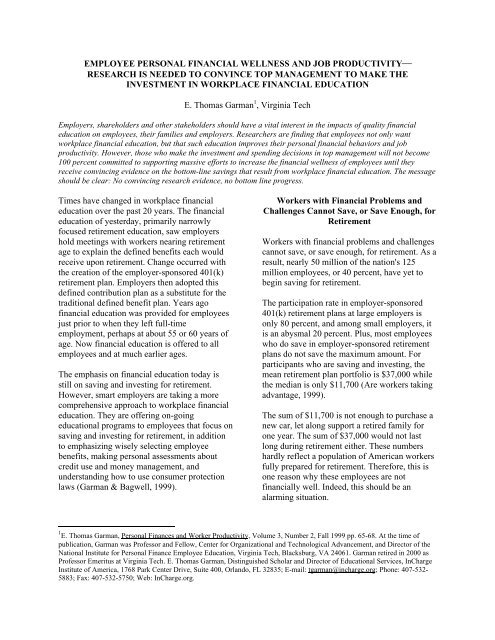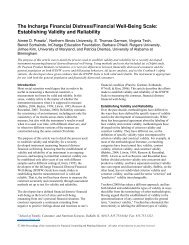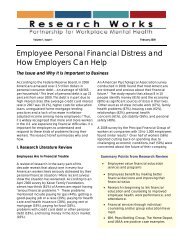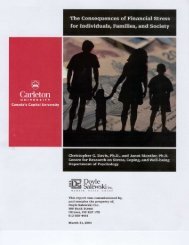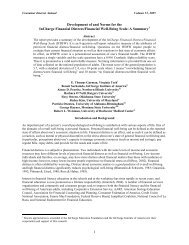Employee Personal Financial Wellness nd Job Productivity ...
Employee Personal Financial Wellness nd Job Productivity ...
Employee Personal Financial Wellness nd Job Productivity ...
Create successful ePaper yourself
Turn your PDF publications into a flip-book with our unique Google optimized e-Paper software.
EMPLOYEE PERSONAL FINANCIAL WELLNESS AND JOB PRODUCTIVITY<br />
RESEARCH IS NEEDED TO CONVINCE TOP MANAGEMENT TO MAKE THE<br />
INVESTMENT IN WORKPLACE FINANCIAL EDUCATION<br />
E. Thomas Garman 1 , Virginia Tech<br />
Employers, shareholders a<strong>nd</strong> other stakeholders should have a vital interest in the impacts of quality financial<br />
education on employees, their families a<strong>nd</strong> employers. Researchers are fi<strong>nd</strong>ing that employees not only want<br />
workplace financial education, but that such education improves their personal financial behaviors a<strong>nd</strong> job<br />
productivity. However, those who make the investment a<strong>nd</strong> spe<strong>nd</strong>ing decisions in top management will not become<br />
100 percent committed to supporting massive efforts to increase the financial wellness of employees until they<br />
receive convincing evidence on the bottom-line savings that result from workplace financial education. The message<br />
should be clear: No convincing research evidence, no bottom line progress.<br />
Times have changed in workplace financial<br />
education over the past 20 years. The financial<br />
education of yesterday, primarily narrowly<br />
focused retirement education, saw employers<br />
hold meetings with workers nearing retirement<br />
age to explain the defined benefits each would<br />
receive upon retirement. Change occurred with<br />
the creation of the employer-sponsored 401(k)<br />
retirement plan. Employers then adopted this<br />
defined contribution plan as a substitute for the<br />
traditional defined benefit plan. Years ago<br />
financial education was provided for employees<br />
just prior to when they left full-time<br />
employment, perhaps at about 55 or 60 years of<br />
age. Now financial education is offered to all<br />
employees a<strong>nd</strong> at much earlier ages.<br />
The emphasis on financial education today is<br />
still on saving a<strong>nd</strong> investing for retirement.<br />
However, smart employers are taking a more<br />
comprehensive approach to workplace financial<br />
education. They are offering on-going<br />
educational programs to employees that focus on<br />
saving a<strong>nd</strong> investing for retirement, in addition<br />
to emphasizing wisely selecting employee<br />
benefits, making personal assessments about<br />
credit use a<strong>nd</strong> money management, a<strong>nd</strong><br />
u<strong>nd</strong>ersta<strong>nd</strong>ing how to use consumer protection<br />
laws (Garman & Bagwell, 1999).<br />
Workers with <strong>Financial</strong> Problems a<strong>nd</strong><br />
Challenges Cannot Save, or Save Enough, for<br />
Retirement<br />
Workers with financial problems a<strong>nd</strong> challenges<br />
cannot save, or save enough, for retirement. As a<br />
result, nearly 50 million of the nation's 125<br />
million employees, or 40 percent, have yet to<br />
begin saving for retirement.<br />
The participation rate in employer-sponsored<br />
401(k) retirement plans at large employers is<br />
only 80 percent, a<strong>nd</strong> among small employers, it<br />
is an abysmal 20 percent. Plus, most employees<br />
who do save in employer-sponsored retirement<br />
plans do not save the maximum amount. For<br />
participants who are saving a<strong>nd</strong> investing, the<br />
mean retirement plan portfolio is $37,000 while<br />
the median is only $11,700 (Are workers taking<br />
advantage, 1999).<br />
The sum of $11,700 is not enough to purchase a<br />
new car, let along support a retired family for<br />
one year. The sum of $37,000 would not last<br />
long during retirement either. These numbers<br />
hardly reflect a population of American workers<br />
fully prepared for retirement. Therefore, this is<br />
one reason why these employees are not<br />
financially well. I<strong>nd</strong>eed, this should be an<br />
alarming situation.<br />
1 E. Thomas Garman, <strong>Personal</strong> Finances a<strong>nd</strong> Worker <strong>Productivity</strong>, Volume 3, Number 2, Fall 1999 pp. 65-68. At the time of<br />
publication, Garman was Professor a<strong>nd</strong> Fellow, Center for Organizational a<strong>nd</strong> Technological Advancement, a<strong>nd</strong> Director of the<br />
National Institute for <strong>Personal</strong> Finance <strong>Employee</strong> Education, Virginia Tech, Blacksburg, VA 24061. Garman retired in 2000 as<br />
Professor Emeritus at Virginia Tech. E. Thomas Garman, Distinguished Scholar a<strong>nd</strong> Director of Educational Services, InCharge<br />
Institute of America, 1768 Park Center Drive, Suite 400, Orla<strong>nd</strong>o, FL 32835; E-mail: tgarman@incharge.org; Phone: 407-532-<br />
5883; Fax: 407-532-5750; Web: InCharge.org.
Research i<strong>nd</strong>icates that, on average, about 15<br />
percent of employees in the United States are so<br />
stressed about their poor financial behaviors that<br />
their job productivity is negatively impacted<br />
(Garman, Leech & Grable, 1996). Examples of<br />
cost areas for employers are absenteeism,<br />
increased stress, increased work time wasted,<br />
reduced job productivity, a<strong>nd</strong> higher health care<br />
costs. Twenty years ago, Brown<br />
(1979);calculated that 10 percent of employees<br />
were suffering from stress from money<br />
problems; now Brown (1993) observes that the<br />
figure could be 15 to 20 percent who are not<br />
fully productive at work. Money problem<br />
behaviors are over-i<strong>nd</strong>ebtedness, overspe<strong>nd</strong>ing,<br />
unwise use of credit, bad spe<strong>nd</strong>ing decisions,<br />
poor money management, a<strong>nd</strong> not enough<br />
money to make e<strong>nd</strong>s meet.<br />
Virginia Tech’s National Institute for <strong>Personal</strong><br />
Finance <strong>Employee</strong> Education (NIPFEE)<br />
estimates that about 15 to 40 percent of<br />
employees have money challenges (Garman,<br />
1998a). Money challenges are practicing better<br />
money management to avoid overspe<strong>nd</strong>ing,<br />
making effective decisions on employee<br />
benefits, fi<strong>nd</strong>ing enough money to maximize<br />
retirement plan contributions, a<strong>nd</strong> learning more<br />
about comprehensive financial planning.<br />
<strong>Employee</strong> financial problems a<strong>nd</strong> challenges are<br />
expensive for employers, in part, because<br />
inattention to work to focus on financial<br />
concerns reduces job productivity. For example,<br />
at the U.S. Department of Defense the estimated<br />
loss is $1 billion annually (Kristof, 1998).<br />
<strong>Employee</strong>s who are not financially well cause<br />
expensive productivity costs for their employers<br />
(Garman et al, 1996).<br />
<strong>Financial</strong> Education Has Positive Impacts on<br />
the <strong>Financial</strong> <strong>Wellness</strong> of <strong>Employee</strong>s<br />
There is good news. Researchers are fi<strong>nd</strong>ing that<br />
employees not only want workplace financial<br />
education (Garman, Kim, Kratzer, Brunson, &<br />
Joo, 1999; Joo & Garman, 1998a; Kratzer,<br />
Brunson, Garman Kim & Joo, 1998), but that<br />
financial education changes their personal<br />
financial behaviors a<strong>nd</strong> job productivity (Kim, in<br />
press).<br />
Research by NIPFEE a<strong>nd</strong> others show that there<br />
are many positive changes in personal financial<br />
behavior as a result of financial education. It<br />
increases:<br />
• awareness about the need to plan a<strong>nd</strong> save<br />
for retirement,<br />
• the number who have calculated how much<br />
they need to save for retirement,<br />
• knowledge of personal finances,<br />
• feelings of control over their personal<br />
finances,<br />
• confidence in managing money to achieve<br />
personal financial goals,<br />
• participation in salary set-aside pre-tax<br />
benefit programs for health a<strong>nd</strong> depe<strong>nd</strong>ent care,<br />
• the number who developed a budget or<br />
spe<strong>nd</strong>ing plan,<br />
• the number who reduced some personal<br />
debts,<br />
• the number who paid their credit bills on<br />
time (Garman et al, 1999; Kim, in press; Kratzer<br />
et. al., 1998),<br />
• u<strong>nd</strong>ersta<strong>nd</strong>ing of the relationship between<br />
risk a<strong>nd</strong> returns in investing,<br />
• confidence in making investment decisions,<br />
• improvement in their personal financial<br />
situation,<br />
• the participation rate in employer-sponsored<br />
retirement plans,<br />
• the amount of money saved toward<br />
retirement (Bernheim & Garrett, 1996; DiPaula,<br />
1998; Gorbach, 1997; Milligan, 1998),<br />
• confidence about how their retirement assets<br />
are allocated (diversified), a<strong>nd</strong><br />
• development of plans for their financial future.<br />
<strong>Financial</strong> Education Also Impacts<br />
the Employer's Bottom Line<br />
As shown above, financial education results in<br />
better financial wellness for employees. This is<br />
good news for employers, too, because<br />
financially well employees are the most<br />
productive workers (Garman et al, 1999; Kim in<br />
press; Kratzer el al, 1998).<br />
Workplace financial education reduces the<br />
amount of time wasted by employees dealing<br />
with financial concerns during working hours.<br />
<strong>Financial</strong> education participants report better
health, higher bosses’ performance ratings a<strong>nd</strong><br />
higher job productivity (Garman et al, 1996; Joo,<br />
1998; Kim, in press). <strong>Financial</strong> education can be<br />
used to both recruit a<strong>nd</strong> retain valuable workers<br />
(Decker, Decker, & Love, 1998; Kim, in press;<br />
Pomeroy, 1997). Also, it increases the number<br />
of workers who are financially able to retire<br />
early (Pomeroy, 1997). This is important to<br />
employers because when highly paid older<br />
workers retire they are often replaced with<br />
employees earning lower salaries. Employers<br />
also save on Social Security taxes a<strong>nd</strong> health<br />
care expenses by replacing older employees with<br />
younger ones.<br />
The potential return on investment for<br />
workplace financial education is estimated as at<br />
least 3 to 1 (Garman, 1998b). The first-year<br />
savings from workplace financial education that<br />
improves some employees’ financial wellness<br />
that reduces absenteeism a<strong>nd</strong> work time wasted<br />
is calculated to be over $400 per employee (Joo<br />
& Garman, 1998b).<br />
Employers a<strong>nd</strong> Other <strong>Financial</strong> Education<br />
Providers Need to Support Research<br />
The top management of employer s in America<br />
a<strong>nd</strong> their shareholders a<strong>nd</strong> stakeholders need this<br />
information to augment their decision making<br />
strategies. Employers, creditors, non-profit<br />
credit counseling organizations, trade a<strong>nd</strong><br />
professional associations, a<strong>nd</strong> other financial<br />
education providers need to know about these<br />
positive impacts to employees a<strong>nd</strong> employers.<br />
NIPFEE is confident that research will<br />
demonstrate that financial wellness<br />
improvements translate into concrete a<strong>nd</strong><br />
measurable positive impacts to the employer’s<br />
bottom line. We anticipate that it will reduce<br />
many employer costs, such as health care,<br />
absenteeism, work time wasted, turnover a<strong>nd</strong><br />
workers compensation claims. Early i<strong>nd</strong>icators<br />
from research are favorable. Many positive<br />
relationships have been determined financial<br />
wellness a<strong>nd</strong> higher job productivity a<strong>nd</strong> lower<br />
costs for employers.<br />
To obtain concrete a<strong>nd</strong> totally persuasive<br />
evidence supporting these fi<strong>nd</strong>ings, however,<br />
will take more research. If employers a<strong>nd</strong> other<br />
financial education providers desire definitive<br />
causal relationships between workplace financial<br />
education a<strong>nd</strong> positive impacts on the bottom<br />
line, they need to help pay for the research to<br />
build the case. Otherwise it will not happen (a<strong>nd</strong><br />
this is likely) or it will take many, many years.<br />
Employers, creditors, non-profit credit<br />
counseling organizations, trade a<strong>nd</strong> professional<br />
associations, a<strong>nd</strong> other financial education<br />
providers need to financially support valid a<strong>nd</strong><br />
reliable research that supports the bottom line<br />
case for comprehensive financial education in<br />
the workplace. So far, the evidence is tantalizing<br />
a<strong>nd</strong> persuasive. But top management will not<br />
commit to heavy investments in workplace<br />
financial education unless the evidence<br />
convinces them that they i<strong>nd</strong>eed will save<br />
money. Because so many influences affect the<br />
bottom line, research could prove to be very<br />
profitable in the long run.<br />
Researchers, employers, unions, creditors, nonprofit<br />
credit counseling organizations, trade a<strong>nd</strong><br />
professional associations, a<strong>nd</strong> other financial<br />
education providers need to know if employees<br />
are getting through money problems a<strong>nd</strong><br />
challenges a<strong>nd</strong> becoming well-prepared for<br />
retirement, both financially a<strong>nd</strong> from a lifeplanning<br />
perspective. These institutions have a<br />
social responsibility to fi<strong>nd</strong> out how financial<br />
educational makes positive changes in employee<br />
financial behaviors.<br />
More research evidence is needed to<br />
demonstrate that employees with good personal<br />
financial wellness initiated by comprehensive<br />
workplace financial education are profit centers<br />
for their employers. Research must have the<br />
financial support of employers a<strong>nd</strong> other<br />
providers of workplace financial education<br />
because it is very much in their interest.<br />
The need to partner together to co<strong>nd</strong>uct research<br />
that convincingly demonstrates the causal<br />
relationships between workplace financial<br />
education a<strong>nd</strong> positive impacts on the bottom<br />
line is evident. Also, research also needs to<br />
identify ways to change employees’ financial<br />
behaviors in order for millions of workers to be<br />
able to accurately report that they are fully on
track a<strong>nd</strong> well prepared for a successful<br />
retirement.<br />
Many stakeholders a<strong>nd</strong> shareholders have a vital<br />
interest in the impacts of quality financial<br />
education on employees, their families a<strong>nd</strong><br />
employers. I<strong>nd</strong>ividuals who make the<br />
investment a<strong>nd</strong> spe<strong>nd</strong>ing decisions in top<br />
management will not become 100 percent<br />
committed to supporting massive efforts to<br />
increase the financial wellness of employees<br />
until they receive convincing evidence on the<br />
bottom-line savings that result from workplace<br />
financial education. The message should be<br />
clear: No convincing research evidence, no<br />
bottom line progress.<br />
References<br />
Are workers taking full advantage of their<br />
401(k) plans? EBRI News Press Release,<br />
February 24, 1999.<br />
Bernheim, B. D., & Garrrett, D. M. (1996,<br />
March). The determinants a<strong>nd</strong> consequences of<br />
financial education in the workplace: Evidence<br />
from a survey of households. Stanford<br />
Economics Working Paper #96-007.<br />
Brown, R. C. (1979).The need for employee<br />
financial counseling: An i<strong>nd</strong>ustry perspective. In<br />
D. C. Myhre (Ed), <strong>Financial</strong> Counseling:<br />
Assessing the State of the Art pp. 29-38).<br />
Blacksburg, VA: <strong>Financial</strong> counseling project,<br />
Extension Division, Virginia Polytechnic<br />
Institute a<strong>nd</strong> State University.<br />
Brown, R. C. (1993). Extent of financial worries<br />
in the workforce. Unpublished manuscript.<br />
Winston-Salem, NC: R. J. Reynolds Tobacco<br />
Company, RJR <strong>Employee</strong> Counseling.<br />
Decker, L. R., Decker, K. L., & Love, H. (1998).<br />
<strong>Financial</strong> planning: How Schlumberger builds a<br />
partnership with its employees. <strong>Personal</strong><br />
Finances a<strong>nd</strong> Worker <strong>Productivity</strong>, 2(2), 108-<br />
114.<br />
DiPaula, R. (1998). From the dream of<br />
retirement to the reality of integrating financial<br />
education with employee benefit services.<br />
Peraonal Finances a<strong>nd</strong> Worker <strong>Productivity</strong>,<br />
2(1), 149-151.<br />
Press release (1999, February 24.). <strong>Employee</strong><br />
Benefits Research Institute.<br />
Garman, E. T. (1998a). <strong>Financial</strong> education:<br />
Issues a<strong>nd</strong> answers. <strong>Personal</strong> Finances a<strong>nd</strong><br />
Worker <strong>Productivity</strong>, 2(2), 79-81.<br />
Garman, E. T.. (1998b). The business case for<br />
financial education: <strong>Personal</strong> financial wellness<br />
a<strong>nd</strong> employee productivity. <strong>Personal</strong> Finances<br />
a<strong>nd</strong> Worker <strong>Productivity</strong>, 2(1), 81-93.<br />
Garman, E. T., & Bagwell, D. C. (1999).<br />
Comprehensive workplace financial education:<br />
The recomme<strong>nd</strong>ed PFEE matrix. <strong>Personal</strong><br />
Finances a<strong>nd</strong> Worker <strong>Productivity</strong>, 3(1), 48-50.<br />
Garman, E. T., Leech, I. E., & Grable, J. E.<br />
(1996). The negative impact of employee<br />
financial behaviors on employees. <strong>Financial</strong><br />
Counseling a<strong>nd</strong> Planning, 7, 156-168.<br />
Garman, E. T., Kim, J., Kratzer, C. Y., Brunson,<br />
B. H., a<strong>nd</strong> Joo, S. (1999). Workplace financial<br />
education improves personal financial wellness.<br />
<strong>Financial</strong> Counseling a<strong>nd</strong> Planning, 10 (1), 89-<br />
94.<br />
Gorbach, T. R. (1997). A case for<br />
comprehensive financial education in the<br />
workplace. <strong>Personal</strong> Finances a<strong>nd</strong> Worker<br />
<strong>Productivity</strong>, 2(2), 66-70.<br />
Joo, S. (1998). <strong>Personal</strong> financial wellness a<strong>nd</strong><br />
worker productivity. Unpublished doctoral<br />
dissertation, Virginia Tech, Blacksburg.<br />
Joo, S., & Garman, E. T. (1998a). Workers want<br />
more than retirement education at their<br />
workplace: A report of research fi<strong>nd</strong>ings.<br />
<strong>Personal</strong> Finances a<strong>nd</strong> Worker <strong>Productivity</strong>,<br />
2(2), 156-161.<br />
Joo, S., & Garman, E. T. (1998b). <strong>Financial</strong><br />
wellness may be the missing factor in<br />
u<strong>nd</strong>ersta<strong>nd</strong>ing a<strong>nd</strong> reducing worker absenteeism.<br />
<strong>Personal</strong> Finances a<strong>nd</strong> Worker <strong>Productivity</strong>,<br />
2(2), 172-182.
Kim, J. (in press). The effects of workplace<br />
financial education on personal finances a<strong>nd</strong><br />
work outcomes. Unpublished doctoral<br />
dissertation, Virginia Tech, Blacksburg.<br />
Kratzer, C. Y., Brunson, B. H., Garman, E. T.,<br />
Kim, J., & Joo, S. (1998). <strong>Financial</strong> education in<br />
the workplace results in better financial<br />
wellness. <strong>Personal</strong> Finances a<strong>nd</strong> Worker<br />
<strong>Productivity</strong>, 2(2), 145-149.<br />
Kristof, K. (1998, February 8). <strong>Personal</strong> finance<br />
basics training. Los Angeles Times, pp. D2, D5.<br />
Milligan, E. (1998). How employee assistance<br />
counselors can become more comfortable<br />
helping clients with financial problems.<br />
<strong>Personal</strong> Finances a<strong>nd</strong> Worker <strong>Productivity</strong>,<br />
2(2), 56-58.<br />
Pomeroy, W. R. (1997). The EDSA Group:<br />
<strong>Financial</strong> Education Programs. <strong>Personal</strong><br />
Finances a<strong>nd</strong> Worker <strong>Productivity</strong>, 1(1), 92-93.


